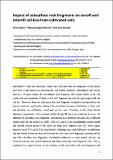Por favor, use este identificador para citar o enlazar a este item:
http://hdl.handle.net/10261/41631COMPARTIR / EXPORTAR:
 SHARE
BASE SHARE
BASE
|
|
| Visualizar otros formatos: MARC | Dublin Core | RDF | ORE | MODS | METS | DIDL | DATACITE | |

| Título: | Impact of subsurface rock fragments on runoff and interrill soil loss from cultivated soils |
Autor: | Smets, Toon; López-Vicente, Manuel CSIC ORCID ; Poesen, Jean | Palabras clave: | surface sealing stony soils rainfall simulation Laboratory experiments |
Fecha de publicación: | nov-2011 | Editor: | John Wiley & Sons | Citación: | Smets T, López-Vicente M, Poesen J. Impact of subsurface rock fragments on runoff and interrill soil loss from cultivated soils. Earth Surface Processes and Landforms 36(14): 1929–1937 (2011) | Resumen: | Field and laboratory studies have indicated that rock fragments in the topsoil may have a large impact on soil properties, soil quality, hydraulic, hydrological and erosion processes. In most studies, the investigated rock fragments still remain visible at the soil surface and only properties of these visible rock fragments are used for predicting runoff and soil loss. However, there are indications that rock fragments completely incorporated in the topsoil could also significantly influence the percolation and water distribution in stony soils and therefore, also infiltration, runoff and soil loss rates. Therefore, in this study interrill laboratory experiments with simulated rainfall during 60 min were conducted to assess the influence of subsurface rock fragments, incorporated in a disturbed silt loam soil at different depths below the soil surface (i.e. 0.001, 0.01, 0.05 and 0.10 m), on infiltration, surface runoff and interrill erosion processes for small and large rock fragment sizes (i.e. mean largest diameter equals 0.04 and 0.20 m, respectively). Although only small differences in infiltration rate and runoff volume are observed between the soil without rock fragments (control) and the one with subsurface rock fragments, considerable differences in total interrill soil loss are observed between the control treatment and both contrasting rock fragments sizes. This is explained by a rapid increase in soil moisture in the areas above the rock fragments and therefore a decrease in topsoil cohesion compared to a control soil profile. The observed differences in runoff volume and interrill soil loss between the control plots and those with subsurface rock fragments is largest after a cumulative rainfall (Pcum) of 11 mm and progressively decreases with increasing Pcum. The results highlight the impacts and complexity of subsurface rock fragments on the production of runoff volume and soil loss and calls for attention in process-based runoff and erosion models. | Versión del editor: | http://onlinelibrary.wiley.com/doi/10.1002/esp.2220/abstract | URI: | http://hdl.handle.net/10261/41631 | E-ISSN: | Online ISSN: 1096-9837 |
| Aparece en las colecciones: | (EEAD) Artículos |
Ficheros en este ítem:
| Fichero | Descripción | Tamaño | Formato | |
|---|---|---|---|---|
| 2011 Belgium FlumeSubsurfRock_Q_E Smets_López-Vicente_Poesen ESPL36_14 D-CSIC.pdf | 2,37 MB | Adobe PDF |  Visualizar/Abrir |
CORE Recommender
Page view(s)
374
checked on 22-abr-2024
Download(s)
285
checked on 22-abr-2024
Google ScholarTM
Check
NOTA: Los ítems de Digital.CSIC están protegidos por copyright, con todos los derechos reservados, a menos que se indique lo contrario.
